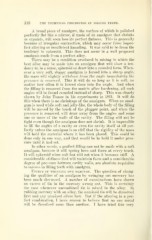Page 650 - My FlipBook
P. 650
318 THE TECHNICAX, PB0CEDUBE8 IN FILLING TEETH.
A broad piece of amalgam, the surface of which is polished
perfectly flat like a mirror, if made of an amalgam that shrinks
or expands, will soon lose its perfect flatness. This is generally
because of irregular contraction, which may occur from imper-
fect alloying or insufficient kneading. It was said to be from the
tendency to spheroid. This does not occur in a well prepared
amalgam made from a perfect alloy.
There may be a condition produced in mixing in which the
best alloy may be made into an amalgam that will show a ten-
dency to, in a sense, spheroid or draw into a rounded form. AVhen-
ever a very soft, sloppy amalgam is forced into a sharp angle,
the mass will slightly withdraw from the angle immediately the
pressure is removed. This it will do so long as it is soft, no
matter how often it is forced close into the angle. And when
the filling is removed from the matrix after hardening, all such
angles will be found rounded instead of sharp. This was clearly
shown by John Tomes in his experiments in 1861. It will do
this when there is no shrinkage of the amalgam. AVlien an amal-
gam is used while soft and jelly-like, the whole body of the filling
will be moved by the touch of the plugger point, and when the
pressure is removed, will draw away from the angles and some
one or more of the walls of the cavity. The filling will not be
tight even though the amalgam does not shrink. It is impossible
to fill the angles of a cavity or even the cavity itself at all per-
fectly unless the amalgam is so stiff that the rigidity of the mass
will hold the material where it has been placed. This could be
done only in one way, and that would be to hold it under pres-
sure until it had set.
In other words, a perfect filling can not be made with a soft
amalgam, because it will spring here and there at every touch.
It will spheroid when soft but will not when it becomes stiff. A
considerable stiffness that will maintain form and a considerable
degree of pressure between cavity walls, are absolute requisites
to success in filling teeth with amalgam.
Effect of wringing out mercury. The question of chang-
ing the qualities of an amalgam by wringing out mercury has
been much discussed. A number of examinations have shown
an excess of tin in the mercury wrung out. This is certainly
the case whenever uncombined tin is mixed in the alloy. In
rubbing mercurj' with an alloy, the unmixed tin will be dissolved
first and any unmixed silver last. But if the alloying is a per-
fect combination, T have reason to believe that no one metal
will be dissolved more than another. I have tried this very


